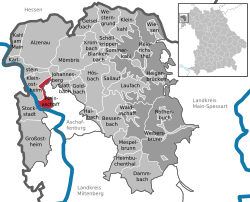Mainaschaff
| Mainaschaff | ||
|---|---|---|
|
||
| Coordinates: 49°59′N 9°5′E / 49.983°N 9.083°ECoordinates: 49°59′N 9°5′E / 49.983°N 9.083°E | ||
| Country | Germany | |
| State | Bavaria | |
| Admin. region | Unterfranken | |
| District | Aschaffenburg | |
| Government | ||
| • Mayor | Horst Engler (CSU) | |
| Area | ||
| • Total | 7.31 km2 (2.82 sq mi) | |
| Elevation | 114 m (374 ft) | |
| Population (2015-12-31) | ||
| • Total | 8,766 | |
| • Density | 1,200/km2 (3,100/sq mi) | |
| Time zone | CET/CEST (UTC+1/+2) | |
| Postal codes | 63814 | |
| Dialling codes | 06021 | |
| Vehicle registration | AB, ALZ | |
| Website | www.mainaschaff.de | |
Mainaschaff is a community in the Aschaffenburg district in the Regierungsbezirk of Lower Franconia (Unterfranken) in Bavaria, Germany. It has a population of around 8,700.
The community lies near the boundary with Hesse, to the west just outside Aschaffenburg. It is located on the Main’s right bank, and on the small river Aschaff, which empties here into the Main. This confluence gave the community its name.
In 1184, Mainaschaff had its first documentary mention as a holding in Pope Lucius III’s privilege for the Kollegiatsstift at Aschaffenburg. In the early 12th century, the small village, which was made up mainly of farms, belonged to the Stift of St. Peter and Alexander in Aschaffenburg. The inhabitants, who made their living mostly by growing fruit and fishing, had to pay ongoing tribute to the Stift, and also perform compulsory labour for it.
Only in 1872 did Mainaschaff become a self-administering community.
The council is made up of 20 council members, not counting the mayor.
The community’s arms might be described thus: A pall reversed wavy argent, dexter barry of six Or and gules, sinister gules a demi-wheel of the first divided palewise the rim towards sinister, the base azure.
The pall reversed (that is, upside-down Y-shape) symbolizes the forks of the rivers Main and Aschaff, which, in a way, also makes the arms canting, as the community’s name is drawn from a fusion of these two rivers’ names. The stripes on the dexter (armsbearer’s right, viewer’s left) side come from the arms formerly borne by the Counts of Rieneck, to whom parts of the community historically belonged. The halved wheel comes from the Electorate of Mainz’s coat of arms, the community having belonged to this state until 1803. The tinctures azure (blue) in the escutcheon’s base and argent (silver) in the pall reversed are Bavaria’s colours, which have flown over Mainaschaff since 1816.
...
Wikipedia



